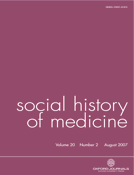-
Views
-
Cite
Cite
Jonathan Reinarz, Water of Life: A History of Wine-Distilling and Spirits from 500 bc to ad 2000, Social History of Medicine, Volume 20, Issue 2, August 2007, Pages 426–428, https://doi.org/10.1093/shm/hkm067
Close - Share Icon Share
Extract
Written by a former keeper of historical records at Leeds University, this erudite book demonstrates an understanding of distilling technologies throughout the ages, unravelling both the diffusion of stills, as well as the language and customs used by those who produced a wide variety of well-known, as well as some long-forgotten, aqua vitae for religious, medical and related purposes. Once thought to have originated in twelfth-century Salerno, the art of distilling is traced by Wilson to first-century Egypt and recounted with much detail into the modern alcopop era.
The first half of the volume provides an expert account of the process of distilling, its ancient origins, including the evolution of stillheads and their diffusion. It also places the role of spirits in various social ceremonies and rituals from their first appearance in pagan texts to late medieval manuscripts. Having ceased within the Roman Empire with the rise of the Orthodox Church which regarded distilling as a dangerous form of magic, the search for an elixir of life encouraged many Europeans, including Cathar missionaries and the Knights Templar, to preserve and develop ‘alchemical methods’ encountered in the Arab world, where medical elixirs were produced by means of distillation and sublimation. By the thirteenth century, distillates of wine were regularly appreciated in Western Europe for their medicinal properties. The treatises of two Bolognese practitioners, Taddeo Alderotti and Teoderico Borgognoni, recall earlier rosewater recipes and describe a marvellous new warming medicine to treat cold diseases, including apoplexy, paralysis, trembling of the limbs and renal stone. Said to improve memory and preserve flesh from corruption, the distilled panacea, it was claimed, could restore youth to the elderly, consume phlegm and reduce both toothache and bad breath. The first printed book on distilled waters appeared in Augsburg in 1477 and was published by Michael Puff von Schrick. The technology of distilling was soon spread from the continent to English monasteries by French monks.




